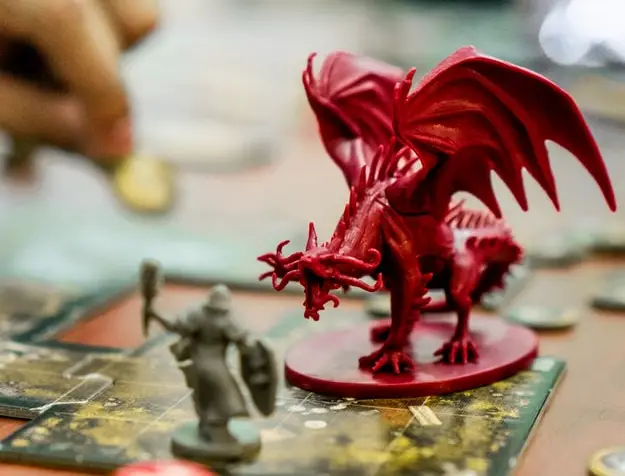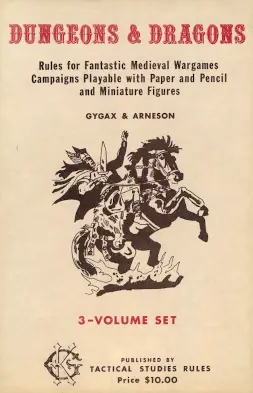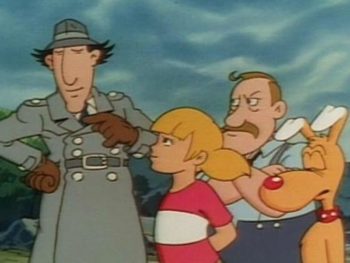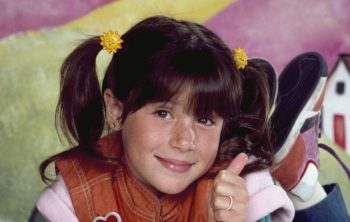
During the 1980s, a real fear started to spread about Satanic cults. Even in an age without the internet and social media, this fear was still able to spread like wildfire and grip the public. And one game became the poster boy for this fear: Dungeons and Dragons.
How did this simple board game create such hysteria, and was it just used as a scapegoat during a time of panic? This is a look back on the Dungeons and Dragons scare of the 1980s.
When I was growing up, there were several things that were off-limits in my house; overly sugary breakfast cereals; going down to watch Saturday morning cartoons before 8 am; The Macy’s Thanksgiving Day Parade. Ok, that last one is an obvious Seinfeld joke, but one restriction that wasn’t a joke was anything to do with Dungeons and Dragons. The game, cartoon, and anything else connected to it was completely off-limits for me.
You can imagine how much this increased its appeal. I once remember getting caught watching the cartoon show and to my mom, this was worse than If I had robbed a bank. Looking back, this show was pretty tame, and the game wasn’t threatening in the slightest. But the legacy of Dungeons and Dragons had grown out of control and in the 1980s; took on a life of its own.
What is The Dungeons and Dragons Game?
I know there’s still a big board game community out there, but I’m not sure if younger kids even play board games anymore? Either way, if this is new to you–or you never actually got to play D&D–here’s a quick breakdown.
This is a fantasy tabletop role-playing game and one that has been considered the most successful in history. It’s played by a group of people around a table and at its essence, is a story-telling adventure game. There are several things you need to play the game. Some core rule books, some specialty dice, and a pen and paper. The core of the game is essentially driven by the player’s imagination and creativity.
Those playing the game assume the roles of the characters in the game and embark on quests. You can obviously see Lord of the Rings parallels here. The quests in Dungeons and Dragons include things like finding treasures, exploring dungeons, and fighting monsters. What makes the game unique is there is no preset winning condition. Players have to interact and work together to make their way through the game.
Whereas other games have a definitive end goal, D&D is more about the journey. It’s about telling a story and the goal is about experiencing this adventure together.
But there are some rules. The game is broken up into two groups: the ones playing it and the Dungeon Master. The players have a single character and that represents a character in the D&D world. There are various species of characters such as humans, elves, and dwarfs. Each character also has specific strengths and weaknesses.
Next, you choose the class of that character. You may be a fighter, a rogue, or a wizard. This is basically your main skill set. Depending on your skill, you may be an expert at casting spells or fighting with a certain type of weapon. Now, the player can create a name and whole backstory of their own choosing for their character. This is where the creative aspect of Dungeons and Dragons really comes into play. This is all filled out on a character sheet.
The player who is the Dungeon Master is like the director of the game. They create the situations and monsters that the players encounter. They create the flow of the game and the direction it takes. They are not the enemy of the game but help to create the world.
Some actions in the game require the rolling of a twenty-sided dice to determine what the outcome will be. There are other dice that can determine how damaged you may be after an attack. And some of the key monsters that can be brought into the game have now become much more familiar thanks to Stranger Things. The average viewer now knows about the Mindflayer, Demogorgon, and Vecna.
The Origins of the Dungeons and Dragons Game

The origins of the game come from a Medieval miniature figure game called Chainmail. It was a war game created by Jeff Perren. Gary Gygax would then take this game but introduce the fantasy element to it and expand on the original gameplay. It was still called Chainmail but they continued to introduce new elements such as character classes and experience points.
The game took shape and the first edition of Advanced Dungeons and Dragons came out in 1974. The name Dungeons and Dragons apparently came from Gygax’s two-year-old daughter who picked the name out of a list of possible titles.
That first edition was put together on a budget of around $2000. The money had to be carefully budgeted and not a lot was left over for the artwork. The game came with three booklets and didn’t have a lot to it. The idea was the purchaser would have some familiarity with wargaming. This was a very niche product that required you to have some previous understanding of this type of game. Wargaming was based on groups and armies, kind of like the game Risk, but with D&D, it was more individual or character-based.
Despite its low budget, the game was indeed popular with wargamers. But its popularity quickly caught on, especially among college students and high schoolers–Or middle schoolers in Hawkins, Indiana. In its first year, around 1,000 copies of D&D were sold. In 1975, 3,000 were sold.
Again, in a time without internet or social media, word-of-mouth would help drive the success of the game. It appealed to creative kids with an interest in fantasy story-telling. Once they realized how creative they could be with this game, it quickly spread. Articles in various game magazines would also help to increase its reach. During this time period, magazines like these and Nintendo Power were basically our internet.
Dungeons and Dragons appealed to adventurous and creative people. And it encouraged teamwork and community. Steven Spielberg famously used D&D while casting E.T. In an article in People Magazine from 1982, they share how he had the young actors play a D&D game during the auditioning process. It gave them more insights into how the actors could interact. Kid actors can fake things in an audition but “when you play that game you have to show ingenuity and quick thinking.” A D&D-like game is even featured in the movie.
Going into the 1980s, more than three million players around the world were involved with the game. By the end of 1981, the company had revenues of nearly $13 million. They projected this to double by 1982. The game was so successful that the publishing company they started–TSR Hobbies–didn’t need to borrow money or depend on anyone else. This whole thing had been created in a basement and within 8 years, they had finished 6th on INC Magazine’s list of fastest-growing privately held companies.
Over the years, many various revised editions would be released such as a more basic version that would help appeal to more novice players. More advanced versions would also be released which would expand beyond the basic rules. This is a very brief overview of an extremely vast game but many other revisions would come out including the Advanced Dungeons and Dragons 2nd edition in 1989. This second edition was specifically released with some alterations because the game had taken on a troubling persona. And this is where our story picks up.
The Fear of Dungeons and Dragons Begins
For years, people were happily playing away at Dungeons and Dragons in their basements. Games could continue for days or even weeks at a time. No one outside of a small community of die-hard gamers had taken any notice of this thing–until one event that happened in 1979.
James Dallas Egbert was a college student and had gone missing. He was a child prodigy and passionate D&D player. He was struggling with everything, disappeared, and left a note behind. When he went missing, a private investigator was brought in. The fear was that Egbert wasn’t going to survive due to how overwhelmed he was with school and the pressures of being a high-level student. Egbert was also found to use drugs. But, for some reason, the private investigator looked past all that and clung to one fact he discovered during this whole process: Egbert playing a game called Dungeons and Dragons.
The private investigator believed that thanks to the game, Egbert had lost the connection between fantasy and reality. This led Egbert to travel through steam tunnels beneath his school while in this delusional state ready to end it all. But then Egbert returned. And he made it clear that all of this was because of the academic pressures he faced. Unfortunately, Egbert ended his life in 1980.
But because this story had become news, a connection with Dungeons and Dragons had been made. For most people, this was the first time they had ever heard of the game. This further grew when in 1982, a TV movie was made about Egbert’s story called Mazes and Monsters. It would star a young Tom Hanks in one of his very first roles.
For those watching the movie (which during an era of only three networks allowed for a huge viewing audience), a real fear developed about this game. Could it hijack the minds of young kids and take them away from reality? Here’s the thing, though, that private investigator would go on to write a book called “The Dungeon Master” where he refuted any connection between the game and Egbert’s condition,
But the seeds had been planted.
In 1982 there was another incident of a student ending his own life. When police searched the room of the student, they found a lot of Dungeons and Dragons material. The student had social issues and trouble fitting in, but had found a group of kids to play D&D with. They would even play at the school. The parents of the student would sue the school for allowing them to play the game there. The suit was thrown out for some other technicalities, but the mother of the student started a crusade against Dungeons and Dragons.
That group would be called B.A.D.D.: Bothered About Dungeons and Dragons.
Bothered About Dungeons and Dragons or B.A.D.D
B.A.D.D was the group that started to warn others of the alleged issues that dungeons and Dragons may cause. The goal of this group was to share with the public all the evils of D&D. And this movement got some big-time traction.
The group would release several books that associated Dungeons and Dragons with some pretty horrific things including demon summoning and cannibalism. This was a period of time when the fear of Satanic cults was at an all-time high and parents believed their kids could be easily drawn in. The work of B.A.D.D would warn parents to actually look out for signs like robbing graves and stealing religious artifacts as signs they had been possessed by D&D.
They also made claims that D&D targeted kids who were intelligent, creative, and with no history of drug use. Basically: the ideal kid. Did this mean that no kid was safe? Was blaming Dungeons and Dragons an easy scapegoat to dismiss negligent parents?
Sensationalist stories are very common today, but they were definitely coming into their own in the 1980s. Outrage has always sold and garnered high ratings and in the 80s, networks were catching on to this. Tabloids like the National Enquirer had significantly grown and the media realized more than ever that hysteria sells. Dungeons and Dragons was the perfect example. In 1985, a notable D&D segment appeared on 60 minutes. You can watch it here on YouTube.
In this episode, they spend time with some kids playing the game. They all seem like regular, great kids, but then there’s the definite focus on how harmful this game may be. It shared stories of the tragic endings of several kids and noted how they all played D&D. Were their tragic stories all due to their love of Dungeons and Dragons? Did they go too far into the game and blue that line between fantasy and reality? If you played this game, how easily could you be “possessed?”
They also sat down with Gygax and TSR’s head of public relations. The two of them point out how millions of kids play the game and the tragic stories represent a minuscule percentage. They also share how there was no clinical evidence of a connection, how it’s just a correlation and all speculative. No one was making connections to the other issues in the lives of the kids in these terrible stories. There was no mention of family or personal issues. They didn’t even blame violent movies or TV shows: it was only Dungeons and Dragons.
In the 60-minute special, they also sit down with one of the heads of B.A.D.D who believed the curse put on her son’s character in the game had carried over into real life. The D&D creators reiterate the point that the game is make-believe. Kids had been reading Lord of the Rings for decades and weren’t becoming possessed. Why was D&D being singled out? But Their opponents continued to say that the role-playing aspect could have major influences on vulnerable kids.
Both sides were not going to be swayed from their viewpoint, and the game’s creators continued to point out how millions of people play it without incident.
The Damage is Done
If you grew up in the 80s, you remember what a juggernaut show 60 Minutes was. In 1985, it was the fourth most-watched show on TV. It had a rating of around 24 which meant a quarter of the viewing public was tuning in. More people watched 60 Minutes than Monday Night Football. To relate this to today, Monday Night Football gets an average rating of around 3.5. In 1985, 60 Minutes had a rating of 23.9.
It can’t be understated how powerful television was in the 1980s and thanks to 60 Minutes, everyone was now aware of Dungeons and Dragons.
Christian groups would condemn it for promoting devil worship, witchcraft, and murder. It was considered an “Occult tool,’ and could influence people to be possessed by demons.
D&D supporters would continue to point out that it was just a game. Playing Super Mario Bros didn’t make them want to jump down giant pipes and try to throw real-life fireballs.
Another sensationalistic piece on Dungeons and Dragons would appear in Newsweek on September 9, 1985. If you’ve watched Stranger Things season 4, you know how this specific article plays a role in this season.
Interestingly, this article came out just a few days before the 60 Minutes special. The article lambasts the game and only uses a few sentences near the end to talk about how it might not be that bad. The next week in Newsweek, a 12-year-old from Virginia named David Bobzien actually wrote to the editor to defend role-playing games and how irresponsible the previous article was. In this published letter, a 12-year-old is trying to explain to adults how games like D&D can be “Tools to learning problem solving and creativity.”
But it all makes sense. Parents that are not involved in the lives of their kids often look for something to blame. instead of pointing the finger at themselves, it has to be an outside entity. Something will always be the scapegoat: Comic books, TV, video games, heavy metal, movies, Rock n Roll music in the 50s, Elvis, Eminem, Alice Cooper, Marilyn Manson, Kiss, and Ozzy Osbourne have all been seen as the devil.
At one point in the 80s, even He-Man was considered to be Satanic.
The Dungeons and Dragons Cartoon
Speaking of cartoons, there was also the Dungeons and Dragons cartoon. It came out on September 17, 1983, on CBS. For those who hated the game, this was the worst time to release a kid’s cartoon show. For the company, this was simply striking while the iron was hot. This cartoon was interesting as usually, a show is released to sell an upcoming toy line. In this case, the game already existed, toys were released to support the game, and the cartoon would support both of them. It was the complete opposite format.
But the network was aware of all the parental concerns and wanted to take that into account to make a more accessible cartoon for kids.
The Dungeons and Dragons cartoon is an extremely creative show that stood out in a sea of watered-down, cookie-cutter alternatives. The premise involves a group of friends transported to the Dungeons and Dragons world after taking a roller coaster ride at an amusement park.
The group has to find its way while avoiding the evil wizard Venger. I’m wondering if we might see him in Stranger Things season 5… The show lasted until 1985 and was made up of 27 episodes including an unfinished finale. Among other voice talents, the D&D cartoon features voices performed by Optimus Prime himself, Peter Cullen, and voice of the 1980s Frank “Megatron” Welker.
Despite the creativity of the show, it was still Dungeons and Dragons, and there was some violence to it. We would eventually get used to the cartoon violence that came from cartoons like GI Joe and Transformers, but the D&D cartoon created too much of a stir. This is still the early 80s, and violence in cartoons did not go over well. Coming out of the 1970s, there were significant restrictions on cartoon violence. But going into the early 80s, regulations had started to be lifted.
One episode in particular, “The Dragon’s Graveyard” from October 20th, 1984, hinted at the characters actually killing Venger. This was pretty astonishing for a Saturday morning cartoon. Even if they wanted to, you didn’t see the Smurfs planning to kill Gargamel. This episode was almost shelved but eventually aired.
However, the National Coalition on Television Violence wasn’t taking this sitting down. Spurned on by all the negative press, they demanded that the FTC run a warning during the show about how the game had been linked to real-life violent deaths. The cartoon may have been intense, but how was a 7-year-old going to react to a message like that? Despite all this, the show led its time slot for nearly two years. And my mom hated it.
If you want an even deeper dive into the Dungeons and Dragons cartoon, check out the excellent video by the Tox Galaxy YouTube channel.
How Did D&D Combat All This?
Going into the later 80s, people were still scared of D&D, and anything that was connected to the game was used as evidence to ban the game. 1988 would be the year of the “D&D killers.” This case involved a couple being attacked in their home. The person involved in this attack was part of a D&D group. Three of them from the group were arrested and found guilty. Opponents of Dungeons and Dragons immediately jumped on this and said the group was influenced by playing the game.
It turns out the act was carried out by the stepson of the couple who was after a million-dollar inheritance. He would only bring it up at D&D games to bounce ideas off of the group over how to pull off the act. Despite having no connection to this incident, it was yet another strike against the fantasy role-playing game.
The creators of D&D couldn’t ignore the horrific press they had been facing for nearly a decade. This would lead them to make some changes to the game.
In 1989, the second edition of Dungeons and Dragons was released. This release limited some of the aspects of the game that had been associated with Satanic cults and the negative press the game had received. There are definitely things in D&D that are not tame, but they removed references to demons and devils and also toned down some of the artwork. They also advanced the game settings beyond just fantasy. Newer gameplay would blend other genres such as science-fiction, horror, and historical mythological settings.
This was smart as these other genres included similar dynamics to D&D fantasy but were not getting the same amount of blame. If parents groups were going to attack fantasy role-play, they would have to go after these other genres including horror which had somehow gotten off the hook. There’s a good Candyman joke in there somewhere, but we’ve got to keep moving.
But the creators behind D&D weren’t going to take all this hysteria lying down. For every one story that might have a negative connection to the game, there were tens of thousands of positive ones. Were psychologists trying to persuade people that the crimes being committed were in fact due to a board game? Was this easier than dealing with the real underlying issues?
Funnily enough, the cartoon show may have helped in softening the negative stigma attached to the game. Once something goes the cartoon route, it just becomes another merchandising entity. How serious can something be that’s sandwiched between The Smurfs and Alvin and the Chipmunk? There were now D&D coloring books, lunch boxes, and even shrinky dinks. It’s hard to feel threatened by something that’s just another commercial cash-grab.
Eventually, the satanic panic would calm down. And Satanic Panic would have made a great band name in the 80s.
Even though the issues surrounding Dungeons and Dragons hung on for years, positive attributes of the game would rise up. Some schools would actually use it in therapy sessions. The game has been used to help students improve their social and emotional goals. It can also create a better sense of community. It was true: kids who played Dungeons and Dragons learned how to work together and solve problems. It would also help kids with social anxiety come out of their shells and socialize with others.
A report aired on PBS has also said the game may be a way to combat screen addiction.
Also, we might not have Stranger Things without it…
Wrapping it Up
I think I can safely say–from looking back at all this–that the Dungeons and Dragons scare was nothing more than unfounded hysteria. Yes, it was connected to some horrible acts, but in those situations, it appears there was something much deeper going on. The game seemed to be more of an innocent bystander and since we always need something to blame; acted as the perfect scapegoat.
Every era will have its own “Dungeons and Dragons.” it’s the thing that everyone will blame instead of asking the tougher questions. The 1980s was a period of satanic fear and D&D emerged as the perfect target.
Those groups of outraged parents were the small minority but seemed to be the most vocal. It’s the same groups that feared Harry Potter would turn millions of kids into sorcerers and witches. That didn’t exactly happen. There always needs to be an enemy and watchdog groups will ride one threat into the ground before moving on to the next “outrage de jour.”
Ultimately, the fear of a board game that was “possessing kids” was unfounded. But it sure did make for great TV and sold a lot of magazines. Maybe it was this growing desire for sensationalism and creating fear that was the real threat all along?



